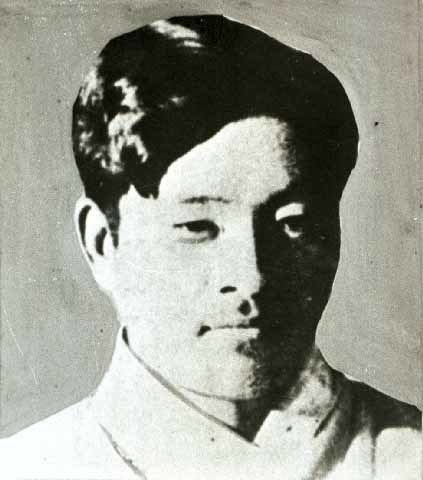Occupation novelist Name Kim You-jeong | Role Novelist Books The Camellias | |
 | ||
Born January 18, 1908
Chuncheon ( 1908-01-18 ) Died March 29, 1937, Seoul, South Korea Movies Daengbyeot, Spring, Wanderer Similar People Lee Hyo‑seok, Chae Man‑sik, Hwang Sun‑won, Shin Bong‑seung, Hah Myung‑joong | ||
Kim You-jeong (Korean: 김유정; also romanised as Kim Yoo-jung, Kim Yu-chŏng and Kim Yu-jeong; 11 January 1908 – 29 March 1937) was a Korean novelist.
Contents
He is one of the famous novelists of Korea, also recognised as the icon of Chuncheon, where he was born. Kim You-jeong Literature Village and Gimyujeong Station, both located in Chuncheon was named after him.
Life
Kim was born in Chuncheon, Gangwon Province on January 11, 1908. He was the son of a wealthy landowner. The family fortunes, however, were whittled away by his older brother, and Kim spent much of his adolescent and adult life in penury. Kim attended what is now Yonsei University in Seoul. He made his literary debut with the publication of "Wanderer Among the Hills” (Sangol nageune) in 1933 and won short fiction contests held by Chosun Ilbo and Chosun joongang Ilbo two years later. In 1935, he became a member of the literary coterie, The Society of Nine (Gu-inhoe), which included such prominent poets and fiction writers as Jeong Jiyong and Lee Sang. He has left us with some thirty stories, most of them published in 1935 and 1936. He died of pulmonary tuberculosis on March 29, 1937.
Work
Kim's work was described as "rich and earthy". He wrote approximately 30 short stories, most of which were published in the three years before his death. His 1936 story The Camellias (동백꽃) is about the residents of a Korean farming village; its implicit sexuality was more explicit in his 1935 Rain shower (소낙비). His 1937 story The scorching heat was considered gloomy.
The prototypical Kim Yujeong protagonist might be the narrator of “Spring, Spring” (Bom bom, 1935), a simpleton who is slow to realize that his wily future father-in-law is exploiting his labor, or the husband in “Scorching Sun” (Ttaengbyeot), too ignorant to know that his wife’s illness is actually due to an overgrown baby in her womb. Bawdy dialogue and colloquial slang heighten the comic potential of such situations, but an undercurrent of sadness suggests the wretchedness of poverty-stricken lives. Embedded within Kim Yujeong’s lyrical approach to nature and robust characterization of peasant wholesomeness are indirect references to questions of class. Conflicts between tenants and middlemen, as well as the problem of absentee landlordism which rose sharply as a result of Japanese agricultural policy hint at the dark and bleak reality of rural Korea in 1930s.
Kim engages the structural contradictions of rural Korean society at a more explicit level in “A Rainy Spell” (Sonakbi) and “Scoundrels” (Manmubang). Both the husband in “A Rainy Spell” and the older brother in “Scoundrels” are dislocated farmers who must drift about after losing their tenancy. In an atmosphere of overwhelming hopelessness and despair, where back-breaking work only leads peasants deeper and deeper into debt, both characters turn to gambling in search of making a quick profit. The husband in “A Rainy Spell” encourages his wife’s sexual union with a wealthy old man for money, and the older brother in “Scoundrels” parts with his wife and child altogether to find means of survival. The speculative spirit which extreme poverty fosters among peasants also manifests itself as gold fever in “Bonanza” (Nodaji, 1935) and “Plucking Gold in a Field of Beans” (Geum ttaneun kongbat). Though most of his stories are sketches of rural communities in decline, Kim also turned his attention to the plight of the urban poor in such stories as “Wretched Lives” (Ttaraji).
Works in Translation
Works in Korean (Partial)
Kim You-jeong Literature Village
Kim You-jeong Literature Village is founded to honor the spirit and literature by restoring her birth home and building exhibition hall on August 6th, 2002. Kim Yu-jeong memorial society held events such as Kim Yu-jeong memorial ceremony, research meeting, literal festival for teenager and so on. Opening hours is 9:30~17:00 in winter season and 9:00~18:00 in summer season. In addition, you can request commentary, but you have to submit application form before at least one week.
